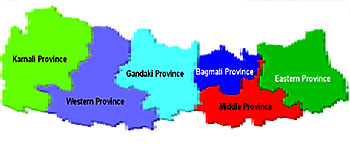 |
It is not easy to create federal states in a country with a topographic and geopolitical make up such as Nepal. Which explains why there are so many opposing views from political parties, political scientists and other experts on how to create provinces and ensure true decentralisation.
The state has settled for a federal structure to basically ensure the representation of all communities in the state mechanism. But the decision should not be taken in a hurry because it will have a lasting impact on the nation and nationalism. The state restructuring should be practicable in terms of administration, distribution of resources and ensuring equal rights of the people living there. A much more practical approach would be to set up the following six provinces:
Eastern Province
(Ilam, Taplejung, Panchthar, Jhapa, Morang, Sunsari, Dhankuta, Tehrathum, Sankhuwasabha, Bhojpur, Solukhumbu, Okhaldhunga, Khotang and Udaypur) Capital: Biratnagar. This does not affect the existing settlement patterns of the various communities and geographic, administrative, educational, cultural as well as physical facilities can remain intact. There are two universities, a regional police office, appellate court, regional administrative office, medical colleges and other institutions in the region. Transportation, electricity and telephone services are already in place.
Middle Province
(Saptari, Siraha, Dhanusha, Mahottari, Sarlahi, Sindhuli, Ramechhap, Rautahat, Bara, Parsa and Makawanpur) Capital: Janakpur. There are universities, appellate court and hospital medical colleges in the region. Water resources include the Kamala, Tamor, Sunkosi, Tamakosi and Bagmati rivers.
Bagmati Province
(Kathmandu, Bhaktapur, Lalitpur, Nuwakot, Rasuwa, Dhading, Dolkha, Sindhupalchok and Kabhre) Capital: Kathmandu. There are universities, medical colleges, courts, police and army headquarters and other institutions. Development infrastructure is relatively developed.
Gandaki Province
(Chitwan, Gorkha, Lamjung, Tanahu, Shyangja, Kaski, Manang, Mustang, Myagdi, Parbat, Baglung, Palpa and Nawalparasi). Capital: Pokhara. The province would be linguistically very diverse, but it is well-endowed with tourism and water resources with the Kali Gandaki, Marsyangdi, Seti, Madi and Chepe rivers.
Western Province
(Rupandehi, Archakhanchi, Gulmi, Kapilbastu, Pyuthan, Rolpa, Dolpa, Rukum, Salyan, Dang, Banke, Bardiya, Surkhet and Jajarkot) Capital: Ghorahi or Tulsipur. Rapti and Bheri are some of the big rivers in this area and there are places of religious significance like Lumbini.
Karnali Province
(Darchula, Jumla, Kalikot, Mugu, Humla, Bajura, Bajhang, Dailekh, Achham, Doti, Kailali, Kanchanpur, Dadeldhura and Baitadi) Capital: Dipayal. There is a regional police office and administrative office. There are appellate courts and army units. This region does not have a university but there are hospitals and most of the districts have roads. Khaptad and Rara lake are the touristic treasures of the region. Because of its underdevelopment this province will require more attention than others.



